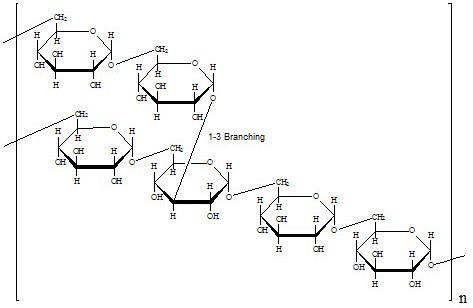葡聚糖
货号:9004-54-0
结构
葡聚糖是葡萄糖酐聚合物。 它由大约 95% 的alpha-D-(1-6)键合组成。其余的 a (1-3) 键合解释了葡聚糖的分支。1,2,3 分支长度的冲突数据意味着平均分支长度小于三个葡萄糖单位。4,5 但是,其他方法表明存在大于 50 个葡萄糖单位的分支。6,7
已发现天然葡聚糖的分子量(MW)在900万至5亿之间。8,9,10 较低MW的葡聚糖表现出较低的分支化4,并且具有更窄的MW分布范围。11 MW大于10,000的葡聚糖表现高度支化。 随着MW的提高,葡聚糖分子会具有更好的对称性。7,12,13 MW在2,000至10,000之间的葡聚糖分子可展现出可膨胀线圈的特性。1212 MW小于2,000的葡聚糖更多是棒状的。14
葡聚糖的分子量通过以下一种或多种方法测定:低角度激光散射15、尺寸排阻色谱法16、铜络合17和蒽酮试剂18、比色法还原糖测定和粘度12。
比旋度:[α]=+199° 11

图 1.比旋度
产品信息
我们提供来自肠膜明串珠菌菌株B 512的葡聚糖。 通过有限的水解和分馏生成各种分子量。我们供应商采用的确切方法已申请专利。分馏可通过尺寸排阻色谱16 或乙醇分级,其中最大分子量的葡聚糖首先沉淀。19
制备说明
右旋糖酐具有很好的水溶性,最高分子量的右旋糖酐除外,货号D5501(MW范围 = 500万至4000万)。 我们测试葡聚糖在水中的浓度通常超过30 mg/mL的溶解度。
葡聚糖也可自由溶于DMSO、甲酰胺、乙二醇和甘油。11
葡聚糖中性水溶液可通过在110-115 °C下高压灭菌30至45分钟而进行灭菌。11葡聚糖可在高温下被强酸水解。葡聚糖的末端还原基团可在碱性溶液中氧化。11
操作流程
右旋糖酐是一种高分子量、惰性、水溶性聚合物,已被广泛应用于生物医学领域。
未修饰的葡聚糖的应用:
血浆填充剂
右旋糖酐溶液已被用作血浆填充剂。20
10% 葡聚糖溶液 (分子量40,000) 比血浆蛋白产生略高的胶体渗透压。
据悉,0.9% 氯化钠或 5% 葡萄糖中的 10% 右旋糖酐 (分子量40,000) 溶液可用作术后血栓栓塞性疾病的短期血浆增量剂。 输注后,24小时后尿液中约70%的葡聚糖(分子量40,000)不变。粪便中有少量排出。 剩余的右旋糖酐缓慢代谢为葡萄糖。
6% 右旋糖酐溶液 (分子量70,000) 的胶体渗透压与血浆蛋白相似。分子量大于 50,000 的右旋糖酐倾向于缓慢扩散穿过毛细血管壁,并缓慢代谢为葡萄糖。大约50%输注的右旋糖酐(分子量70,000)在24 小时内尿中排泄不变20。
离心/细胞和细胞器分离
含右旋糖酐 (分子量250,000) 的胶体溶液已用于离心分离血液中聚集的血小板21 白细胞22 和淋巴细胞23。
葡聚糖 (分子量40,000) 已被用于分离完整的细胞核。24
蛋白质沉淀
在免疫扩散应用中,葡聚糖已被用于增强抗体-抗原复合物的沉淀和敏感性。
将右旋糖酐 (分子量80,000) 以最大80 mg/mL注入免疫电泳凝胶中。25
右旋糖酐(分子量 250,000 和 2,000,000)也用于类似的应用。26
抑制血小板聚集
较低浓度的右旋糖酐 (分子量 10,000-40,000) 已用于抑制血小板聚集。27
参考文献
如要继续阅读,请登录或创建帐户。
暂无帐户?